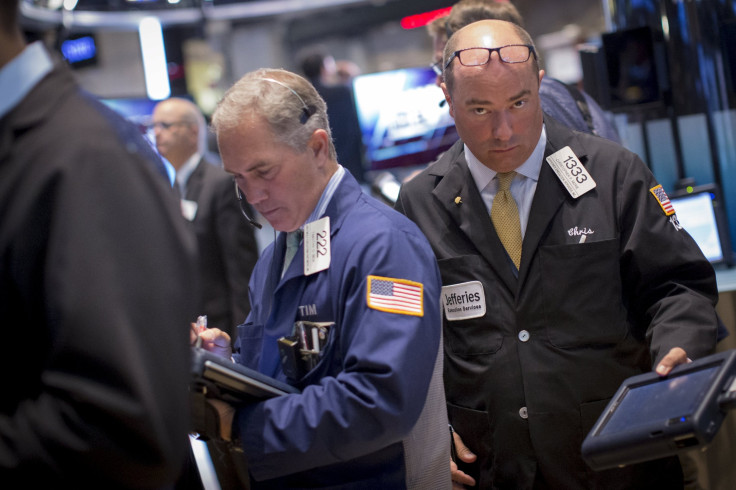Dow Jones Industrial Average Drops 100 Points As Apple Inc (AAPL) And Intel Corporation (INTC) Drop 1%

U.S. stocks traded lower Tuesday as investors weighed a surge in the trade gap that revealed the economy most likely contracted in the first three months of 2015. The declines Tuesday were driven largely by the technology sector and losses in biotech, with the Dow Jones Industrial Average and the Nasdaq composite falling below 18,000 and 5,000, respectively.
The Dow (INDEXDJX:.DJI) tumbled 105.3 points, or 0.5 percent, to 17,957.23. The Standard & Poor's 500 (INDEXNASDAQ:.IXIC) lost 15.11 points, or 0.71 percent, to 2,099.18. The Nasdaq composite (INDEXSP:.INX) dropped 61.25 points, or 1.22 percent, to 4,956.25.
Declines from technology companies led the Dow lower, as iPhone-maker Apple Inc. (NASDAQ:AAPL) and chipmaker Intel Corporation (NASDAQ:INTC) dropped 1.7 percent and 1.3 percent, respectively. For the year, Apple has gained nearly 15 percent while shares of Intel have dropped 10 percent.
Shares of Microsoft Corporation (NASDAQ:MSFT), the world's largest software company, dipped 0.7 percent.
Meanwhile, Dow component Walt Disney Co. (NYSE:DIS) was the biggest gainer in the blue-chip index, rising around 1 percent after the entertainment giant posted quarterly earnings and revenue that beat Wall Street expectations. Disney’s first-quarter revenue was boosted by sales of $3.76 billion at its parks and resorts unit and revenue of $5.81 billion from its media networks.
Notable companies reporting quarterly results after the closing bell include News Corp., Groupon Inc., Herbalife Ltd. and Weight Watchers International Inc.
The Nasdaq was also weighed down Tuesday after the iShares Nasdaq Biotechnology Index (exchange traded fund) dropped 1.5 percent, led by a nearly 4 percent decline from Celladon Corp. (NASDAQ:CLDN).
"We’ve actually had a good run up for a couple of days in a row now with nice gains in the stock market, so a little pause here isn’t too unexpected," said Mike Baele, managing director at U.S. Bank Wealth Management in Portland, Oregon. "But that trade deficit number was a pretty big number, so that might have caught the markets a little off guard this morning."
The U.S. trade gap surged in March to its highest level since October 2008 as imports rebounded strongly after being held down by a labor dispute at West Coast ports. The trade deficit jumped 43.1 percent to $51.4 billion in March from $35.9 billion, the Commerce Department said Tuesday.
The surge in the trade deficit means the U.S. economy contracted slightly in the first quarter, Paul Ashworth, chief economist at Capital Economics, said in a research note Tuesday. The 7.7 percent jump in imports was mainly because the West Coast ports began to work through their backlogs in March following the resolution of the labor dispute in February.
“Assuming that most of the catch-up is now complete, then imports should fall back in April, bringing the trade deficit down to a more normal level too,” Ashworth said.
The March trade data will prompt a downward revision to first-quarter GDP, but it won't be gigantic. The second estimate will show a modest decline of roughly 0.3 percent annualized, rather than a 0.2 percent annualized increase, Ashworth said.
Separately, the U.S. services sector dipped from a seven-month high in April as new business growth eased last month. The Purchasing Managers Index for the services sector fell to 57.4 in April, down from a reading of 59.2 in March, financial firm Markit said in its final reading Tuesday.
However, the Institute of Supply Management’s nonmanufacturing index topped expectations in April, coming in at 57.8, up from 56.5 in March. A reading below 50 indicates contraction in the manufacturing sector while a number above 50 means expansion.
U.S. crude oil rose to more than $60 a barrel Tuesday for the first time since December as West Texas Intermediate crude, the benchmark for U.S. oil prices, gained 2.8 percent to $60.57 a barrel, for June 15 delivery, on the New York Mercantile Exchange. Brent crude, the benchmark for global oil prices, rose 2.2 percent to $67.92 a barrel, for June 15 delivery, on the London ICE Futures Exchange.
© Copyright IBTimes 2024. All rights reserved.






















